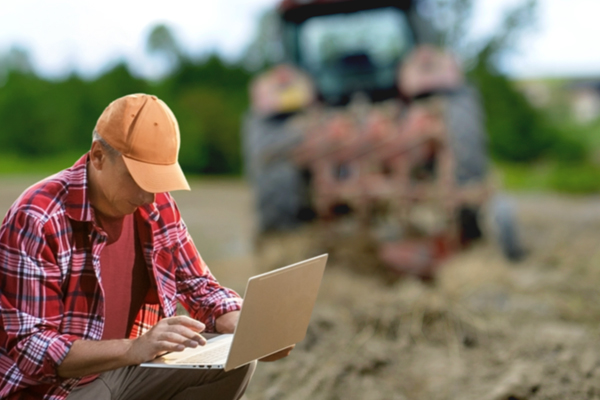When tech companies talk about the future of farming, they paint a picture of AI-powered drones surveying fields, robots harvesting crops and big data optimising every seed planted. But for the growing number of small-scale farmers in the UK who are working with nature rather than against it, this high-tech vision misses the point entirely.
These farmers don’t want to be separated from their land by screens and algorithms – they became farmers precisely to work outdoors, build community and nurture soil health. Yet they’re not anti-technology. The question is: what digital tools actually help farmers who are trying to grow food sustainably while making a living? At heart, this is a question of technological sovereignty – who controls the tools that shape the future of farming and to what ends?
Our research project examined how to co-create digital tools that are appropriate for farming with nature. We began by interviewing 11 farmers about their use of digital tools on their farm and their views on current and future digital technologies. What we found was that the developments currently receiving a lot of attention and funding, such as big data, AI and automation through drones and robots, are not suitable for these farmers.
The right tool for the job
But still, we found that farmers do use a lot of digital tools already. Websites, online shops and sales apps, e-mail newsletters, social media, spreadsheets and land mapping tools are common. This is, of course, on top of non-digital technologies, such as hand tools, polytunnels and small-scale machinery. What these technologies have in common is that they do not remove people’s connection from each other and the land. For example, while a potato planter tractor implement makes a hard job easier, many farmers used affordable old-fashioned ones where three people do the job together, rather than a fully automated one that would isolate one person doing the job alone.
Almost ubiquitous are shared spreadsheets to coordinate work, plan crops and rotation and document the development of plants and animals. While some would prefer using alternatives to big tech solutions, farmers are pragmatic and use what is available and cheap or free, like Google Sheets. In addition, they described some open-source products as “clunky” or “unworkable”.
This is not to say that spreadsheets are an ideal solution. While they are flexible, some farmers still find them too rigid and keep their plans in their head, but this limits opportunities for others to take part and learn. Spreadsheets can also get complex and don’t represent data visually well, making them hard to read. Farmers also said it can be challenging to motivate volunteers or even paid staff to collect the data and fill them in.
Learning and sharing is an important aspect of agroecological farming and farmers also use digital tools to connect with another and share farming knowledge. Because there is often no time for in-person meetups, WhatsApp groups, e-mail lists and online fora hosted by organisations such as the Landworkers’ Alliance, Pasture for Life, or Soil Association are key venues to feel less alone in a landscape dominated by conventional farming.
One tension that emerged was around growing food agroecologically – no chemical inputs, building soil health, fostering biodiversity – while facing the pressures of the market economy. To keep their margins, farmers have to monitor crops and animals more consistently. Rather than selling to intermediaries they sell directly to customers, despite the many headaches this causes when dealing with payment providers, regulations and delivery logistics.
Some farms use third-party apps like Ooooby, which provides a one-stop solution to sell food, manage customers, handle payments and work out delivery logistics. It reduces the administrative burden, but the subscription fee cuts into margins and creates a dependency to an external company they have little control over. Most interviewed farms continue to use spreadsheets to manage customers and sales – with the same issues mentioned above.
Another tension concerned the use of government subsidies such as the Sustainable Farming Incentive (SFI) in England. This scheme pays to reduce carbon emissions or enhance wildlife (e.g., conservation grazing, wildflower meadows, hedges, woodland, etc.) However, payments per hectare are relatively small, so only big farms benefit from it. For small farms, the payments are often not worth the effort of filling in complex application forms or collecting data to evidence the measures taken. There is a lack of low-effort tools to collect data.
Some farmers saw potential in Biodiversity Net Gain – a scheme that pays farmers to set aside land long-term for wildlife and sell ‘biodiversity credits’ to developers who need to buy credits, for example when building housing. While this could generate income, other farmers were very sceptical of the dangers of commodifying land, which often goes hand in hand with a need for digital technology and comprehensive data collection.
What farmers value and need
The farmers we spoke to manage a balancing act: produce food sustainably while also make a living. The use of technology can contribute to that if it is appropriate. Based on our interviews, we argue that “appropriate” in this context means primarily four things:
- Any technology needs to be necessary in the first place. Technology for its own sake is useless. Low tech solutions that preserve human labour are preferred over high-tech automation.
- The technology needs to be practical. It needs to be robust and work outdoors in the rain, cold, or mud (which typically excludes smartphone apps) and support diverse crops and flexible schedules based on natural cycles.
- The technology needs to be accessible. It needs to be affordable (subscription fees are problematic), easy to use and usable by multiple people on the farm.
- The technology should be sustainable. It should use less energy and materials, be easy to build, maintain and repair by farmers themselves, or by using local help – and it needs to be adaptable to new practices and conditions.
What seems clear is that better tools could support agroecological farmers to make a living while not turning food into a commodity.
There is potential for technology that helps reducing the workload of manually collecting and recording data and other administrative tasks, such reporting and funding applications. Sensors could be useful, so long they don’t require humans to be looking at screens rather than looking at their land and experiencing nature.
However, what actually should be and can be recorded needs to be defined by each farmer depending on their circumstances and needs. In this vein, there is very minimal potential for autonomous robots and drones. Most promising are simple automations, such as irrigation and ventilation in polytunnels.
On the other hand, better collaborative tools could make agroecological farming, which is a community and team effort, easier. Collaboration could also be extended beyond the farm gate, for example by coordinating crop plans among many small growers, exchanging seeds, or sharing tools and equipment.
Learning and knowledge exchange could also be better supported with digital tools and platforms. Currently, information is fragmented and hard to find. Formal agricultural training is still mostly attached to conventional standards.
Finally, better tools could support agroecological farmers to make a living while not turning food into a commodity.
Working with farmers
If and how any of these ideas would be taken forward can only be answered by farmers themselves. Often new technologies are developed because there is a technological opportunity and then companies try to find a market.
Agroecology demands that farmers are part of the development from the get-go and control and own both the process and the final outcome. Grassroots networks, such as Farm Hack in the UK, offer alternative to commercial routes.
At a Farm Hack, farmers meet over a weekend and learn from each other how to build the right tools for the job. They also share blueprints and designs for tools open source online. Initiatives like this embody the principle of technological sovereignty – farmers taking back control over the means of production, maintenance and innovation. However, they could go beyond occasional meetups and provide more consistent opportunities and support.
In addition, more could be done to connect farmers with technologists, makers and citizen scientists to co-create appropriate technologies.
How could farmers build control and therefore sovereignty, over their own technology through networks that are accessible to everyone? How can they collaborate with technologists not only in the creation of new tools, but also long-term for maintenance and repair?
These are the questions we want to answer next.
Our next phase aims to create sustained connections between farmers, technologists, makers and citizen scientists. Imagine collaborative platforms that help small growers coordinate crop plans and share equipment. Picture knowledge networks like India’s Andhra Pradesh Community Managed Natural Farming, or BILIM in Eastern Europe, Central and Western Asia, but adapted for British conditions. Envision sales apps that don’t just process transactions but invite customers to volunteer and attend farm events, strengthening the community bonds that make agroecology thrive.
The technology these farmers need already exists in pieces. What’s missing is the collaboration to put these pieces together in ways that serve farmers’ actual needs.
As one farmer put it, like the potato planter, they need tools that preserve the joy of working the land while making sustainable farming economically viable. That’s not a technological challenge – it’s a design challenge that requires farmers at the centre of every decision. The question isn’t whether technology can help agroecological farming, but whether we can develop technology that truly serves those who feed us while caring for the earth.
- Dr Sebastian Prost is a Lecturer in Human-Computer Interaction and is an academic at the School of Science and Technology of City St George’s, University of London.
- The project – to research and design project with small-scale agroecological farmers in North England – is led by Dr Prost together with Prof Jon Rogers and Dr Henry Collingham from Northumbria University in Newcastle, Dr Clara Crivellaro and Dr Nick Taylor from Newcastle University, as well as Prof John Vines from Edinburgh University.

